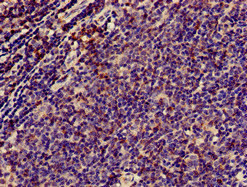![CD3e (T-Cell Marker) (C3e/2479), CF594 conjugate, 0.1mg/mL [26628-22-8] CD3e (T-Cell Marker) (C3e/2479), CF594 conjugate, 0.1mg/mL [26628-22-8]](https://biotium.com/wp-content/uploads/2018/10/BNUB2479.jpeg)
CD3e (T-Cell Marker) (C3e/2479), CF594 conjugate, 0.1mg/mL [26628-22-8]
BNC942479
ApplicationsWestern Blot
Product group Antibodies
ReactivityBovine, Human, Mouse
TargetCD3E
Overview
- SupplierBiotium
- Product NameCD3e (T-Cell Marker) (C3e/2479), CF594 conjugate, 0.1mg/mL [26628-22-8]
- Delivery Days Customer9
- ApplicationsWestern Blot
- CertificationResearch Use Only
- ClonalityMonoclonal
- Clone IDC3e/2479
- Concentration0.1 mg/ml
- ConjugateOther Conjugate
- Gene ID916
- Target nameCD3E
- Target descriptionCD3 epsilon subunit of T-cell receptor complex
- Target synonymsCD3epsilon, IMD18, T3E, TCRE, T-cell surface glycoprotein CD3 epsilon chain, CD3-epsilon, CD3e antigen, epsilon polypeptide (TiT3 complex), CD3e molecule, epsilon (CD3-TCR complex), T-cell antigen receptor complex, epsilon subunit of T3, T-cell surface antigen T3/Leu-4 epsilon chain
- HostMouse
- IsotypeIgG1
- Protein IDP07766
- Protein NameT-cell surface glycoprotein CD3 epsilon chain
- Scientific DescriptionThe immunogen for this Mab is derived from the extracellular domain of CD3 epsilon chain. CD3 consists of five different polypeptide chains (designated as gamma, delta, epsilon, zeta, and eta) with MW ranging from 16-28 kDa. The CD3 complex is closely associated at the lymphocyte cell surface with the T cell antigen receptor (TCR). Reportedly, CD3 complex is involved in signal transduction to the T cell interior following antigen recognition. The CD3 antigen is first detectable in early thymocytes and probably represents one of the earliest signs of commitment to the T cell lineage. In cortical thymocytes, CD3 is predominantly intra-cytoplasmic. However, in medullary thymocytes, it appears on the T cell surface. CD3 antigen is a highly specific marker for T cells, and is present in majority of T cell neoplasms. Primary antibodies are available purified, or with a selection of fluorescent CF® Dyes and other labels. CF® Dyes offer exceptional brightness and photostability. Note: Conjugates of blue fluorescent dyes like CF®405S and CF®405M are not recommended for detecting low abundance targets, because blue dyes have lower fluorescence and can give higher non-specific background than other dye colors.
- SourceAnimal
- ReactivityBovine, Human, Mouse
- Storage Instruction2°C to 8°C
- UNSPSC12352203

![CD3e (T-Cell Marker) (C3e/2479), CF594 conjugate, 0.1mg/mL [26628-22-8] CD3e (T-Cell Marker) (C3e/2479), CF594 conjugate, 0.1mg/mL [26628-22-8]](https://biotium.com/wp-content/uploads/2018/10/BNUB2479-1.jpeg)
![CD3e (T-Cell Marker) (C3e/2479), CF594 conjugate, 0.1mg/mL [26628-22-8] CD3e (T-Cell Marker) (C3e/2479), CF594 conjugate, 0.1mg/mL [26628-22-8]](https://biotium.com/wp-content/uploads/2018/10/BNUB2479-2.jpeg)






